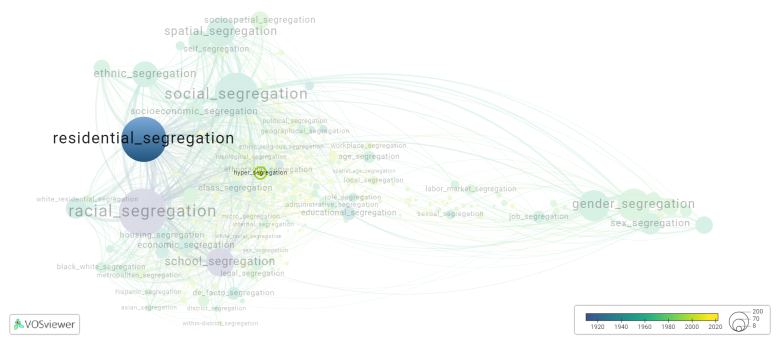Hyper segregation
Date and country of first publication[1]
2006
United States
Definition
Hyper segregation is a term used to describe extreme levels of racial and economic segregation in a particular area. This typically involves the concentration of a specific racial or economic group in certain neighborhoods or areas, leading to limited social interaction and opportunities for residents of different backgrounds. Hyper segregation is often associated with systemic discrimination and inequality, resulting in disparities in access to resources, services, and opportunities for marginalized communities.
See also
Related segregation forms
Hyper segregation is frequently discussed in the literature with the following segregation forms:
residential segregation, ethnic segregation, multigroup segregation, status segregation, socioeconomic segregation, racial segregation

This visualization is based on the study The Multidisciplinary Landscape of Segregation Research.
For the complete network of interrelated segregation forms, please refer to:
References
Notes
- ↑ Date and country of first publication as informed by the Scopus database (December 2023).
Hyper segregation appears in the following literature
Fossett M. (2006). Ethnic preferences, social distance dynamics, and residential segregation: Theoretical explorations using simulation analysis. Journal of Mathematical Sociology, 30(3-4), 185-273. https://doi.org/10.1080/00222500500544052
Marmolejo-Duartey C., Batista-DóRia de Souza N.J. (2011). Urban conditions and socioeconomic segregation: An analysis for Maceió Alagoas, Brazil; [Estructura urbana y segregación socioresidencial: Un análisis para Maceió Alagoas, Brasil]. Papeles de Poblacion, 17(70), 247-286. https://doi.org/
Curley A.M. (2016). A New Place, a New Network? Social Capital Effects of Residential Relocation for Poor Women. Networked Urbanism: Social Capital in the City, 85-103. Taylor and Francis.https://doi.org/10.4324/9781315597805-7
Carhill-Poza A. (2017). “If you don't find a friend in here, it's gonna be hard for you”: Structuring bilingual peer support for language learning in urban high schools. Linguistics and Education, 37(), 63-72. Elsevier Ltd.https://doi.org/10.1016/j.linged.2016.09.001
Weffer S.E. (2017). Are the Truly Disadvantaged Truly Demobilized? Neighborhood Disadvantage and Protest in Chicago, 1970 1990. Critical Sociology, 43(2), 267-289. SAGE Publications Ltd.https://doi.org/10.1177/0896920515623074
Hendrickson C.S. (2018). Ending racial profiling in the church: Revisiting the homogenous unit principle. Mission Studies, 35(3), 342-365. Brill Academic Publishers.https://doi.org/10.1163/15733831-12341589
del Pulgar C.P. (2021). DISMANTLING THE JUST CITY: The unevenness of green experiences in Amsterdam Noord. The Green City and Social Injustice: 21 Tales from North America and Europe, 35-48. Taylor and Francis.https://doi.org/10.4324/9781003183273-3
Johnson J.H., Jr., Bonds J.M., Parnell A.M., Bright C.M. (2021). Coronavirus Vaccine Distribution: Moving to a Race Conscious Approach for a Racially Disparate Problem. Journal of Racial and Ethnic Health Disparities, 8(4), 799-802. Springer Science and Business Media Deutschland GmbH.https://doi.org/10.1007/s40615-021-01051-2
Bell M. (2021). The Color Line and the Classroom: Racialized Space and the Making of Neoliberal Schools. Political Economy: Theories, Principles and Politics, 191-213. Nova Science Publishers, Inc..https://doi.org/
